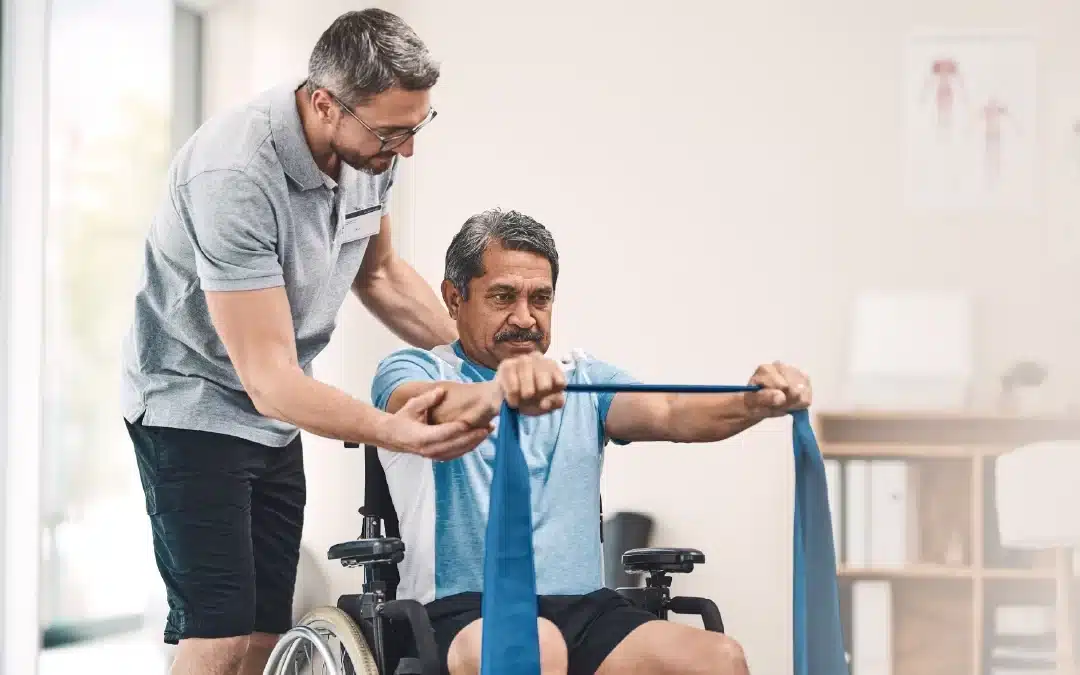As individuals age, the wear and tear on their bodies can lead to chronic conditions like arthritis, osteoporosis, and muscle degeneration, which often manifest as persistent pain. Physiotherapy for seniors can address pain issues, offering a more personalised and gentle approach compared to other treatment modalities.
Unlike acute pain, which is temporary and specific, chronic pain is ongoing and can occur in various parts, including the lower back, hip, legs, shoulders, and neck, making its management more complex.
This pain can lead to reduced mobility, depression, and a decreased quality of life. Understanding the nature of chronic pain in seniors is crucial for effective treatment.
Physiotherapy for Seniors
Geriatric physiotherapy stands out due to its patient-centric approach, considering the various health challenges and limitations of ageing. The primary goals of physiotherapy for seniors are to alleviate pain, improve bodily function, and enhance quality of life. A combination of manual therapy, tailored exercises, and education about pain management and lifestyle changes can help.
For instance, a senior with arthritis may benefit from joint mobilisation techniques and specific exercises to maintain joint flexibility and muscle strength. Physiotherapists also coordinate with other healthcare professionals to ensure a comprehensive care plan.
Techniques Used in Physiotherapy for Seniors
Physiotherapy encompasses a variety of techniques, each tailored to address specific conditions and patient needs. These techniques alleviate pain, improve movement, restore function, and prevent disability.
Here’s an overview of some standard physiotherapy techniques:
1. Manual Therapy
Manual Therapy involves the physiotherapist’s physical manipulation of muscles and joints. Techniques include massage, mobilisation, and manipulation. Manual Therapy can help reduce pain, improve joint mobility, decrease muscle tension, and increase circulation.
- Massage: When done correctly, massage can help improve circulation, reduce muscle tension, and promote relaxation.
- Mobilisation: Involves slow, controlled movements to joints to improve their range of motion and flexibility.
- Manipulation: A more forceful technique than mobilisation, manipulation involves applying a rapid, direct force to a joint to increase its range of motion and reduce stiffness.
2. Exercise Therapy
This cornerstone of physiotherapy involves prescribing specific exercises to strengthen muscles, improve flexibility, and increase endurance. It can be customised for each individual and can include:
- Stretching Exercises: They involve stretching muscles and joints to improve flexibility and range of motion.
- Strengthening Exercises: Using resistance training to build muscle strength.
- Aerobic Conditioning: To improve cardiovascular health and overall stamina.
- Balance and coordination exercises are particularly important for elderly patients or those recovering from injuries.
3. Electrotherapy
This technique uses electrical energy for medical treatment. Common types include:
- TENS (Transcutaneous Electrical Nerve Stimulation) involves applying low-voltage electrical currents to stimulate muscles and joints and relieve pain.
- Ultrasound Therapy: The Therapy uses high-frequency sound waves to treat deep tissue injuries by warming the tissues, which can reduce inflammation, increase circulation, and accelerate healing.
- Laser Therapy: The technique involves applying low-level lasers to reduce pain and inflammation and promote tissue repair.
4. Hydrotherapy
Also known as aquatic Therapy, it involves exercises in a pool. The buoyancy, warmth, and resistance to movement underwater help reduce pain and stiffness and improve strength.
5. Respiratory Physiotherapy
This includes exercises and techniques to improve lung function and assist in clearing mucus from the respiratory system, which is particularly important for patients with chronic respiratory conditions.
6. Heat and Cold Therapy
These are simple yet effective techniques for pain management.
- Heat Therapy: Applying heat increases blood flow, relaxes muscles, and reduces joint stiffness. It can be applied using hot packs, heating pads, or warm baths.
- Cold Therapy: reduces inflammation, swelling, and pain. It’s often used immediately after an injury. Methods include ice packs, cold wraps, and ice massage.
The Benefits of Physiotherapy for Seniors
-
Reduced Pain and Improved Comfort:
Regular physiotherapy for seniors can alleviate chronic pain, leading to a more comfortable and active lifestyle.
-
Increased Independence and Mobility:
As strength and balance improve, seniors can perform daily activities with less assistance.
-
Fall Prevention:
One can significantly reduce the risk of falls and related injuries with better balance and coordination.
-
Enhanced Mental Health:
Physical activity and pain reduction can improve mood and cognitive function.
How to Get Started with Physiotherapy for Seniors
-
Consultation with a Healthcare Provider:
A thorough medical assessment is essential to tailor the physiotherapy for seniors to the individual’s specific needs.
-
Choosing the Right Physiotherapist:
It’s essential to find a physiotherapist who specialises in senior care and understands the complexities of treating elderly patients.
-
Setting Goals:
Together with the physiotherapist, seniors should set realistic goals for their mobility, strength, and overall health.
-
Commitment to the Process:
Regular attendance and adherence to prescribed exercises at home are crucial for the success of the Therapy.
Conclusion
In conclusion, physiotherapy for seniors effectively manages chronic pain and improves the quality of life for older people. Its tailored approach addresses seniors’ unique challenges, focusing on pain relief, functional improvement, and enhanced independence. As the population ages, the demand for skilled geriatric physiotherapists will continue to grow, highlighting the importance of this specialised field in healthcare. By embracing physiotherapy, seniors can look forward to a more active, pain-free, and fulfilling life.
Kites Seniorcare specialises in geriatric physiotherapy and is dedicated to providing comprehensive care to enable seniors to carry out their daily activities by reducing chronic pain and improving their mobility.
Connect with us and talk to our expert for guidance. Write to us at hello@kitesseniorcare.com

